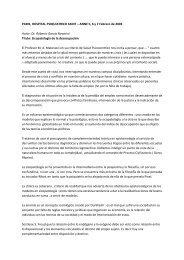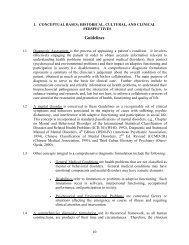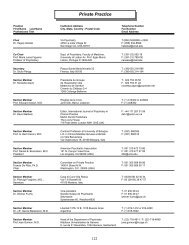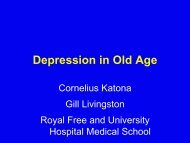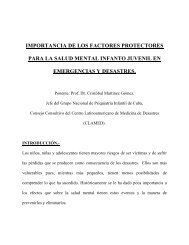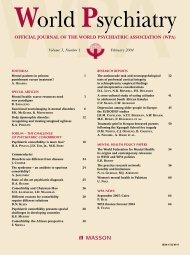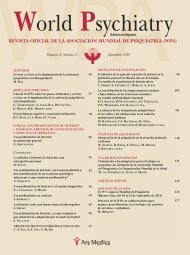ABSTRACTS - World Psychiatric Association
ABSTRACTS - World Psychiatric Association
ABSTRACTS - World Psychiatric Association
Create successful ePaper yourself
Turn your PDF publications into a flip-book with our unique Google optimized e-Paper software.
UL13.<br />
COMBINED AND SEQUENTIAL TREATMENT<br />
STRATEGIES IN DEPRESSION<br />
AND ANXIETY DISORDERS<br />
G.A. Fava<br />
Affective Disorders Program, Department of Psychology,<br />
University of Bologna, Italy<br />
There is increasing awareness that monotherapy (whether pharmacotherapy<br />
or psychotherapy) is unlikely to yield full remission in<br />
mood and anxiety disorders. The joint use of psychotherapeutic and<br />
pharmacological strategies has produced limited benefits when the<br />
two treatments have been administered simultaneously. More promising<br />
results have been obtained with their sequential combination,<br />
particularly when psychotherapeutic approaches have followed the<br />
administration of pharmacotherapy. In unipolar depression, there is<br />
substantial evidence that decreasing residual symptoms and/or<br />
increasing psychological well-being and coping skills in remitted<br />
patients may decrease relapse rate during follow-up up to 6 years. The<br />
sequential strategy does not fall within the realm of maintenance<br />
treatments. It is an intensive, 2-stage approach, which is based on the<br />
fact that addressing one dimension of illness after an earlier feature<br />
has improved can increase the likelihood of more complete and lasting<br />
remission. The planning of treatment in mood and anxiety disorders<br />
requires determination of the first line approach (e.g., pharmacotherapy)<br />
and tentative identification of other areas of concern to be<br />
addressed by concomitant or subsequent treatment.<br />
UL14.<br />
MULTIMODAL MANAGEMENT OF ANOREXIA<br />
AND BULIMIA NERVOSA<br />
K.A. Halmi<br />
Weill Medical College, Cornell University, New York, NY, USA<br />
The allostatic model is useful to conceptualize the development of the<br />
multimodal management of anorexia and bulimia nervosa. Allostasis<br />
is a dysregulation of brain reward circuits in response to the failure of<br />
homeostasis, a self-regulating process for multi system coordination<br />
of an organism’s response to an acute challenge, starvation in anorexia<br />
nervosa (AN) and binge/purge behavior in bulimia nervosa (BN).<br />
The state of allostasis reflects both genetic and environmental factors<br />
and the allostatic load represents the presence of excessive demand<br />
on regulatory systems. Multiple brain mechanisms could contribute<br />
to produce the allostatic state that underlies the severe psychopathology<br />
in anorexia and bulimia nervosa. Evidence exists for biological<br />
vulnerabilities and genetic factors leading to an allostatic state in<br />
these disorders. Dysfunction of neurotransmitters (serotonin,<br />
dopamine and norepinephrine) regulating eating behavior are present,<br />
as well as aberrations of neuropeptides (NYP, opioids, leptin,<br />
CCK, ghreline, melanocortins, adiponectin, agouti-related protein<br />
and BDNF) which affect eating. Genetic studies show significant<br />
linkage on chromosome 1 for restricting AN and on chromosome 10<br />
for BN. The key multimodal elements in the treatment of AN and BN<br />
are commensurate with the allostatic model. Medical management<br />
requires weight restoration with nutritional rehabilitation, rehydration<br />
and correction of serum electrolytes. The core eating disorder<br />
psychopathology requires specific cognitive-behavioral therapy. Adolescents<br />
with eating disorders require family therapy. Comorbidities<br />
and severe impairment of function require pharmacotherapy. Few<br />
randomized controlled treatment trials exist to provide guidelines for<br />
treatment of AN. In the past 5 years, additional family therapy studies<br />
and an olanzapine-placebo controlled trial have provided evidence<br />
for treatment of AN. In a recent trial, adolescents with BN were effectively<br />
treated with family therapy. Innovative treatments are especially<br />
needed for adults with chronic AN. Attention must be focused on<br />
resistance to treatment and extremely high dropout rates.<br />
UPDATE SYMPOSIA<br />
US1.<br />
THE EVOLVING SCIENCE AND PRACTICE<br />
OF PSYCHOSOCIAL REHABILITATION<br />
US1.1.<br />
DEVELOPMENTS IN PSYCHOSOCIAL<br />
REHABILITATION: INNOVATION OR RE-INVENTION<br />
R. Warner<br />
Department of Psychiatry, University of Colorado Health Sciences<br />
Center, Denver, CO, USA<br />
Since the Second <strong>World</strong> War, we have seen tremendous changes in<br />
psychosocial rehabilitation methods. The development of the therapeutic<br />
community, dramatic reforms in hospital care and early discharge<br />
to the community have led to the dissolution of large psychiatric<br />
institutions across the developed world. The psychosocial clubhouse<br />
has proven useful in tackling the powerlessness, boredom and<br />
social exclusion that many people with mental illness experience when<br />
they achieve a stable existence in the community. Supported employment<br />
and social firms have helped address the problem of unemployment.<br />
Cognitive behavioral therapy seeks to decrease the discomfort<br />
created by persistent psychotic symptoms, and cognitive remediation<br />
aims to reduce the handicap caused by the cognitive symptoms of psychosis.<br />
Which of these developments are truly an innovation and<br />
which are a reformulation of an earlier approach What social, political<br />
and economic factors drive the emergence of new rehabilitation<br />
methods What are the next barriers we must confront<br />
US1.2.<br />
VOCATIONAL REHABILITATION IN EUROPE:<br />
LESSONS FROM THE EQOLISE TRIAL<br />
T. Burns<br />
University of Oxford, UK<br />
The severely mentally ill invariably have low rates of employment<br />
despite extensive rehabilitation efforts. Recently there has been a shift<br />
in vocational rehabilitation in mental health, away from the more traditional<br />
structured rehabilitation programmes (often referred to as<br />
“train-and-place”) to more direct “place and train” approaches. The<br />
most widely researched of these approaches is independent placement<br />
and support (IPS) and several US randomized controlled trials<br />
have demonstrated very significant advantages over high-quality traditional<br />
rehabilitation measured as obtaining open employment.<br />
However, we have learnt from bitter experience that complex community<br />
interventions do not always work as well when translated to<br />
different social contexts, and the European employment situation is<br />
very different to that in the US. We conducted a multisite trial of IPS<br />
in Europe. The trial involved a random allocation of 302 psychotic<br />
subjects, 50 from within each of six European countries, to either IPS<br />
or local standard vocational rehabilitation. Subjects were followed up<br />
for 18 months by independent researchers. Primary outcome was<br />
7




